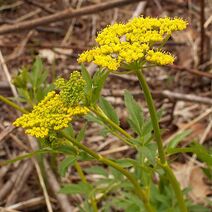Zizia aurea
| Zizia aurea | |
 | |
| Light: | |
| Moisture: | |
| Hardiness: | 3 |
| Soil pH: | 5.6-8.4 |
| Self Pollinated | |
| Height: | 2' |
| Blooms: | Late Spring-Early Summer |
| Native to: | |
| Nectary | |
| Edible Rating: | |
| Medicinal Rating: | |
| Tea: | Yes |
Zizia aurea (common name: golden alexanders)
This carefree delicate flower provides early, long-lasting color and easily reseeds in many sun and soil combinations. A member of the carrot family, the aromatic blossoms are an important food source for short-tongued pollinators while its leaves serve as a larval host for Black Swallowtail Butterflies. Both the leaves and fruit slowly turn mauve in Autumn. Do not confuse this native flower with Pastinaca sativa, a highly invasive Eurasian biennial commonly found on roadsides and disturbed areas with its leaves that can cause blisters.
Propagation: Seed - we have no information for this species but it is probably best sown in spring in a cold frame. When they are large enough to handle, prick the seedlings out into individual pots and grow them on in the greenhouse for their first winter. Plant them out into their permanent positions in late spring or early summer, after the last expected frosts.
Cultivation: Requires a moist soil and a position in full sun[1].
Suitable for the wild garden and other informal plantings as well as collections of native wild flowers[1].
Range: Eastern N. America - Quebec to Saskatchewan and south to Texas and Florida..
Habitat: Moist meadowland[1]. Dry woods and rocky outcrops[2]. Low woods in Texas[3].
Edibility: The flowers, with the main stem removed, are a welcome addition to a tossed green salad. They are also a delicious cooked vegetable when used in a similar manner to broccoli[4].
Medicinal: A tea made from the root is febrifuge[2][5]. The root is also believed to be vulnerary and hypnotic[2].
Pollinators: Insects
Soil: Can grow in light, medium, and heavy soils.
Flower Type: Hermaphrodite
Known Hazards: There is a report that the root might be toxic[2].
Links
References
- ↑ 1.0 1.1 1.2 Huxley, Anthony. The New Royal Horticultural Society Dictionary of Gardening. MacMillan Press, 1992.
- ↑ 2.0 2.1 2.2 2.3 Foster, Steven and Billy Tatum. Medicinal Plants of Eastern and Central North America. Houghton Mifflin, 1990.
- ↑ Diggs, George and Barney Lipscomb. Illustrated Flora of North Central Texas. Botanical Research Institute, 1999.
- ↑ Facciola, Stephen. Cornucopia - A Source Book of Edible Plants. Kampong Publications, 1990.
- ↑ Moerman, Daniel. Native American Ethnobotany. Timber Press, 1998.